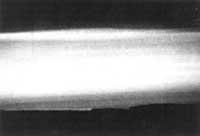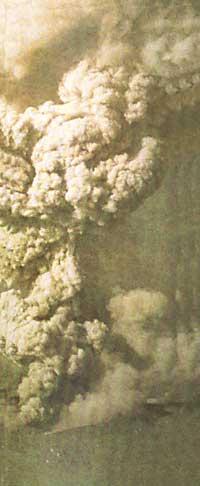Ozone, an overly manipulated problem
1997/09/01 Uriarte, Anton Iturria: Elhuyar aldizkaria
Although the problem of stratospheric ozone is a politically almost finished issue, it does not occur at the scientific level. For some it is clear that due to the different interests, the magnitude and risk of the facts have increased and that in many respects, in addition to offering a superficial view, in many cases it has been falsified.
For example, the most important and the essence of the alarm, that is, the addition of harmful ultraviolet radiation, has not been confirmed. On the contrary, the increase in tropospheric ozone and the growth of cities cause the human population, in general, to receive less and less ultraviolet solar radiation. News from highly polluted Chinese cities speaks of the problem of the lack of ultraviolet and non-excessive radiation that can influence children's physical development, since the vitamin D provided by the sun is necessary for healthy growth.
In many cases, in the Federal District of Mexico, increased tropospheric ozone can cause more serious harm to human health than the possible thinning of stratospheric ozone, especially in the respiratory system. In light terms, tropospheric ozone has been considered “bad”, toxic and “good” that of the stratosphere, which protects us from ultromorous radiation. But this is not true either. Molecule by molecule, tropospheric ozone absorbs these rays before those of the stratosphere, which "protects" us not only from toxicity but also from ultraviolet radiation. The problem, however, may be overprotected, to the point that it hinders the benefits of ultraviolet solar radiation.
There is growing doubt that the phenomenon known as “ozone hole” in Antarctica, which is only a temporary decrease in the ozone layer on the continent, is a new phenomenon. The increase in stratospheric chlorine would probably aggravate the problem, although there is no better place for this phenomenon to occur, both because of the difficulties to live in it and the low incidence of solar radiation on it.

There is no doubt that the low ozone air that can spread to more populated areas (Patagonia, South Africa, southern Australia) has significant negative effects on local plants and animals. Just observe on the internet, any day, the map of the distribution of ozone to realize that the tropical north of Australia, due to the radiation suffering from its location, has a layer of ozone thinner than the south closest to the Antarctic hole.
On the other hand, it seems clear that the interannual variability of the thermal and dynamic states of the polar atmosphere affects more the change of periodic holes than the constant chemical transformations of human effects.
Another misconception that has spread is the irretroactivity of the ozone destruction process as a non-renewable resource. However, in some past events, such as cataclysmic volcanic eruptions, ozone levels may be somewhere below the Pinatubo eruption in June 1991 and below enough. With the event of Pinatubo the height in Europe fell by 8%. And life, before and now, continues. And the ozone level also increased.
Although the manufacture of CFCs in the most developed countries has been prohibited since 1996, gases from refrigerators and insulating foams increase the amount of stratospheric chlorine, which will continue to increase, but in a much shorter time than expected by scientists and magicians, since CFCs were considered to always go to the atmosphere.
The ban agreement in the CFC was a fairly simple political and economic decision, as powerful states and industries were not harmed. Rather the other way around. The main chemical manufacturing industries of CFCs, the multinationals Dupont and ICI, proposed the replacement of HCFCs, rounding the business and strengthening the monopoly. It is not surprising, therefore, that the governments of the United States and the United Kingdom are the main protagonists of the Montreal agreement. It should be noted, moreover, that the compromise came before determining the quantitative relationship between the amount of stratospheric chlorine and the variation of the ozone balance below. To adjust the ratio it is necessary to know precisely what chlorinated compounds the atmospheric chlorine is distributed and how and under what conditions this distribution is modified. Also, and above all, know the influence of polar stratospheric clouds.
In fact, polar stratospheric clouds are known to play a decisive role in the incidence of chlorine in ozone activation or destruction processes. In the process of temporary dismantling, one of these two factors, the increase in the polar stratospheric cloud or the increase in the concentration of chlorine, is to reveal the greatest impact it produces. And the factor that determines the formation process of these clouds is not the greater or lesser number of stratospheric chlorine, but the temperature and stratospheric dirt.
Denitrification reactions in the stratosphere are also fundamental, since without them chlorine does not influence, but we are still far from calculations to determine its speed. It is known, for example, that sulfated aerosols emitted by volcanoes denitrify the atmosphere and, while maintaining the same amount of chlorine, it becomes more effective in the process of ozone destruction. The normal level of sulfated products admitted by the stratosphere is unknown, but it is believed that due to the last eruptions it is dirtier than normal, which would logically affect the level of ozone balance.
Finally, note that the two frequently mentioned atmospheric disasters are still mixed today: the ozone layer hole and global warming caused by the greenhouse effect. On many occasions, an explanation has been given as naive as it is simple to explain the relationship between the massive arrival of radiation through the hole in the ozone layer that warms the earth's surface.
The truth is that the possible thinning of the ozone layer would mean a simple increase in solar energy that would reach the surface, since the ultraviolet radiation that absorbs ozone is very small compared to the total energy we receive from the sun, less than 0.04%. Paradoxically, the consequence is the opposite, that is, the cooling of the surface due to the thinning of the ozone layer. Like ozone, water vapors and CO2, it is a greenhouse gas that prevents the loss of infrared radiation that the terrestrial surface pours into space, returning it down, increasing the equilibrium temperature of the terrestrial surface. Its possible decrease would mean a cooling of the earth's surface, but it is possible that, against the noise extracted, the problem of the next decades is an increase in global ozone and not a decrease.
In the case of global warming, they will not reach an agreement as simple as that of Montreal. Warming the world a little is not as striking as the possible cancer caused by the alleged destruction of ozone on the planet. The Russians and Chinese, and they are not few, would do well if the average temperature rose one or two degrees. On the other hand, there is no consensus on economic interests, as in the case of the CFC, but two different areas.
On the one hand, and in the paradoxical alliance, utopian ecologists and supporters of nuclear energy, and on the other, the realistic majority that will continue to use and use for years traditional energy resources (based on coal, oil and gas).

Gai honi buruzko eduki gehiago
Elhuyarrek garatutako teknologia





